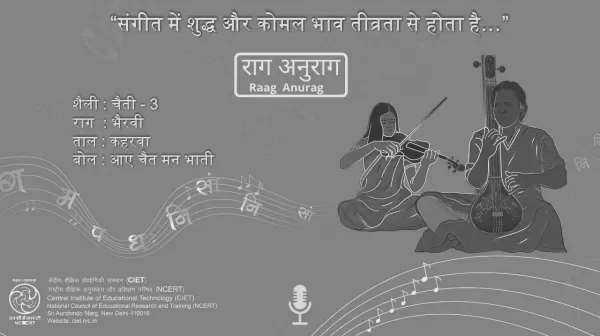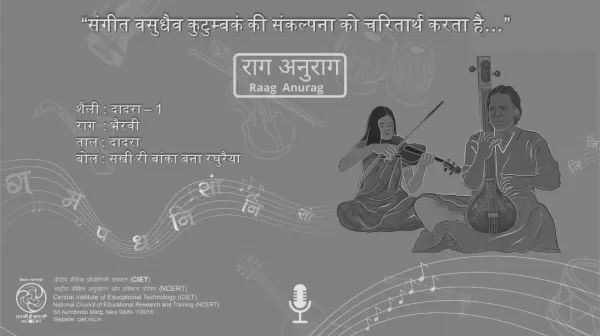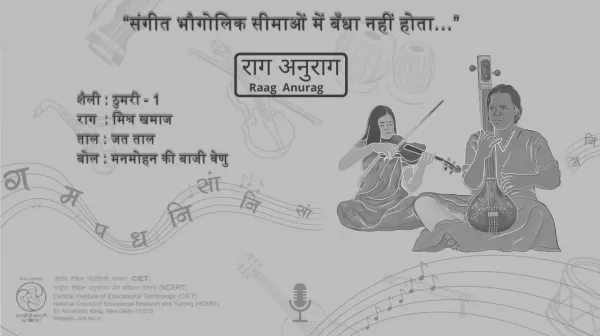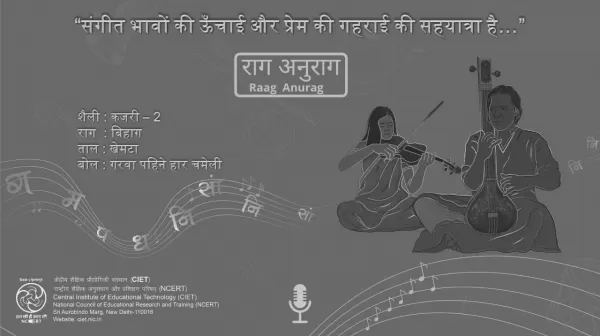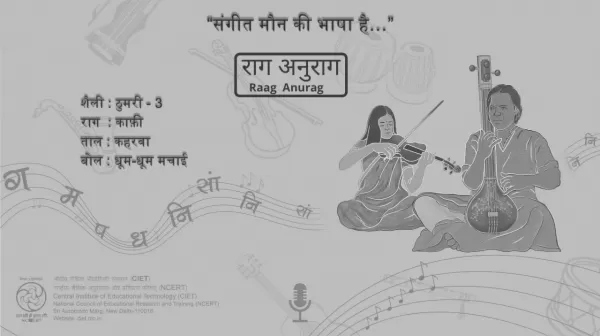Rag Anurag NCERT
Malhar 1 Rag "Gaud Malhar Umad Ghumad"
Based on rainy season Malhar is a semi classical style of singing. Malhar itself mean “the rain.” Semi classical “Bandish” (Determined melody structure) are chiefly sung in this rag. Its main themes of this rag are the rain, love and the nature. This rag has a very prominent place among the seasonal ragas. It creates very melodious environment. Let know in short about Rag Gaudh Malhar before we listen to the malhar based on this rag. This Rag is very melodious, captivating and powerful but at the same time is difficult to sing. This Rag is also known as Gaudh.
Thumri 5 Rag Bhairavi "Phul Gendwa Na Maaro"
Thumri is one of the styles of Hindustani music having parts and sub parts. It comes under semi classical music. Expression of emotions is more emphasized in it in comparison to the purity of Rag. So is the reason that it is categorized under semi classical singing. The “Bandish” (Determined melody structure) is short in Thumri with prominence of essence of adornment and ornamentation. However, devotion based Bandish is also sung in Thumri. The Ragas used in Thumri are generally of fickle and playful tendencies such as Khamaj , Peelu, Bhairwi, Kafi, Gaurh Sarang and Des etc.
Thumri 4 Rag Gaud Sarangi "Kaise Jaaun Neer Bharan Panghatwa"
Thumri is one of the styles of Hindustani music having parts and sub parts. It comes under semi classical music. Expression of emotions are chiefly emphasized in it in comparison to the purity of Rag. So is the reason that it is categorized under semi classical singing. The “Bandish” (Determined melody structure) is short in Thumri with prominence of essence of adornment and ornamentation. However, devotion based Bandish is also sung in Thumri. The Ragas used in Thumri are generally of fickle and playful tendencies such as Khamaj , Peelu, Bhairwi, Kafi, Gaurh Sarang and Des etc.
Thumri 3 Rag Kafi " Dhoom Dhoom Machai"
Thumri is one of the styles of Hindustani music having parts and sub parts. It comes under semi classical music. Expression of emotions is more emphasized in it in comparison to the purity of Rag. So is the reason that it is categorized under semi classical singing. The “Bandish” (Determined melody structure) is short in Thumri with prominence of essence of adornment and ornamentation. However, devotion based Bandish is also sung in Thumri. The Ragas used in Thumri are generally of fickle and playful tendencies such as Khamaj , Peelu, Bhairwi, Kafi, Gaurh Sarang and Des etc.
Thumri 2 Rag Des "Mathura gaye more Shyam"
Thumri is one of the styles of Hindustani music having parts and sub parts. It comes under semi classical music. Expression of emotions is more emphasized in it in comparison to the purity of Rag. So is the reason that it is categorized under semi classical singing. The “Bandish” (Determined melody structure) is short in Thumri with prominence of essence of adornment and ornamentation. However, devotion based Bandish is also sung in Thumri. The Ragas used in Thumri are generally of fickle and playful tendencies such as Khamaj , Peelu, Bhairwi, Kafi, Gaurh Sarang and Des etc.
Thumri 1 Rag Mishra Khamaj "Manmohan Ki Baji Venu"
Thumri is one of the styles of Hindustani music having parts and sub parts. It comes under semi classical music. Expression of emotions is more emphasized in it in comparison to the purity of Rag. So is the reason that it is categorized under semi classical singing. The “Bandish” (Determined melody structure) is short in Thumri with prominence of essence of adornment and ornamentation. However devotion based Bandish is also sung in Thumri. The Ragas used in Thumri are generally of fickle tendencies such as Khamaj , Peelu, Bhairwi, Kafi, Gaurh Sarang and Des etc.
Malhar 3 Rag "Miyan Malhar Mat Bol Koyaliya Matwari"
Based on rainy season Malhar is a semi classical style of singing. Malhar itself mean “the rain.” Semi classical “Bandish” (Determined melody structure) are chiefly sung in this rag. Its main themes of this rag are the rain, love and the nature. This rag has a very prominent place among the seasonal ragas. It creates very melodious environment. Rag Miyan Malhar comes from the Kafi That. The Wadi swara is Pancham (So) and the Samwadi swara is Sa (Doh). Dha (La) note is forbidden in its ascension. Gandhar (Me) and Ni (Ti) both are sharp notes with rest notes as natural notes.
Malhar 2 Rag "Miyan Malhar Maai Ban Bolan Lage More"
Based on rainy season Malhar is a semi classical style of singing. Malhar itself mean “the rain.” Semi classical “Bandish” (Determined melody structure) are chiefly sung in this rag. Its main themes of this rag are the rain, love and the nature. This rag has a very prominent place among the seasonal ragas. It creates very melodious environment. Now, before listening to Malhar based on Rag Miyan Malhar, let’s know in short regarding Rag Miyan Malhar. Rag Miyan Malhar has incepted from Kafi family. The wadi swara is Sa (Doh) and the Samwadi swara is Pa (Soh).
Kajri 2 Rag "Bihag Garva Pahine Haar Chameli"
Kajri is one of the semi classical styles of Indian music originated from the folk music of the Indian state of Uttar Pradesh. It is mainly sung in the month of Savana, which is mid-July to mid-August in accordance with the English calendar. So let us listen to Kajri which is based on rag Bihag. Let’s have some basic information about Rag Bihag. This Rag is originated from Bilawawl that. In the ascension of this rag, Re and Dha (Re and La ) are forbidden. Both Ma (Fa) notes are used in it whereas all other notes are natural.
Kajri 1 Rag Mishra "Peelu Aae Sawan Adhik Suhavan"
Kajri is semi classical style of music. It is a well-known folk genre evolved eventually from the folk of Uttar Pradesh, one of the Indian states. It is mainly sung during the rainy season which is mid-July to mid-August according to English calendar. Now, let have a brief information about Rag Mishr Peelu in Taal Kaharwa. Rag Peelu derives from Kafi thhat or melody family. Its Wadi swara is Gandhar (Me) and Samwadi swara is Nishad (Ti). In the ascension of this raga Rishabh (Re) and Dhaiwat (La) are forbidden and both Gandhar (Ga), both Dhaiwat (La) and both Nishad (Ti) are used.

